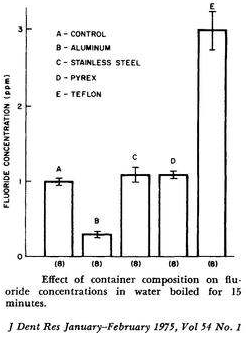Teflon Pans
In 1975, Full and Parkins reported in the Journal of Dental Research that boiling water in teflon plans produced a “pronounced increase” in fluoride levels. An excerpt from this study is reproduced below. Teflon is made from fluorinated chemical, and thus the relationship between Teflon use and fluoride contamination of food is plausible.
The following is an excerpt and figure from the Full and Parkins study:

“The fluoride concentrations observed before and after boiling for each container and the change in fluoride concentrations are shown in the illustration. A pronounced increase was seen with the Teflon-coated vessel. The boiled water from the aluminum vessel showed notable decrease. Little change was noted in the fluoride concentration of the water boiled in the stainless steel and Pyrex vessels. The amount of water remaining in each vessel was estimated; in the aluminum, stainless steel, and Pyrex vessels water was reduced by a third and in Teflon by a half. . . .
The variation of fluoride content in foods prepared in cooking vessels of different compositions should be studied. The magnitude of the composition effects seen with the aluminum and steel containers suggests that significant alterations in fluoride uptake into boiled foods may occur.”
Despite the potential significance of these findings to the fluoride exposures of millions of Americans, there has been virtually no careful attempt in the subsequent 37 years to replicate the findings. One small-scale study in a state dental journal (that FAN does not have a copy of) apparently found no increase in the fluoride content from Teflon use, but such a small obscure study can hardly be deemed sufficiently adequate to resolve the issue one way or the other.
SOURCE: Full CA, Parkins FM. (1975). Effect of cooking vessel composition on fluoride. Journal of Dental Research 54: 192.
-
-
The Absurdities of Water Fluoridation
[caption id="attachment_10205" align="alignleft" width="190"] Paul Connett, PhD[/caption] Water fluoridation is a peculiarly American phenomenon. It started at a time when Asbestos lined our pipes, lead was added to gasoline, PCBs filled our transformers and DDT was deemed so "safe and effective" that officials felt no qualms spraying kids in school classrooms
-
Why I am now officially opposed to adding fluoride to drinking water
https://www.youtube.com/watch?v=iF-hKlIgCuM April, 2000 To whom it may concern: Since April of 1999, I have publicly decried the addition of fluoride, especially hydrofluosilicic acid, to drinking water for the purpose of preventing tooth decay. The following summarize my reasons. New evidence for lack of effectiveness of fluoridation in modern times. [caption id="attachment_10211" align="alignleft" width="150"] Dr. Hardy
-
50 Reasons to Oppose Fluoridation
Introduction [caption id="attachment_11821" align="alignleft" width="200"] Dr. Paul Connett[/caption] In Europe, only Ireland (73%), Poland (1%), Serbia (3%), Spain (11%), and the U.K. (11%) fluoridate any of their water. Most developed countries, including Japan and 97% of the western European population, do not consume fluoridated water. In the U.S., about 70% of public water supplies are
Related Articles:
-
-
-
Fluoride & IQ: 76 Studies
Note: See the Updated list of fluoride IQ studies at https://fluoridealert.org/researchers/fluoride-iq-studies/the-fluoride-iq-studies/ • As of July 18, 2022, a total of 85 human studies have investigated the relationship between fluoride and human intelligence. • Of these investigations, 76 studies have reported that elevated fluoride exposure is associated with reduced IQ in humans. • The studies
-
Fluoride's Effect on Fetal Brain
The human placenta does not prevent the passage of fluoride from a pregnant mother's bloodstream to the fetus. As a result, a fetus can be harmed by fluoride ingested pregnancy. Based on research from China, the fetal brain is one of the organs susceptible to fluoride poisoning. As highlighted by the excerpts
-
Fluoride: Developmental Neurotoxicity.
Developmental Neurotoxicity There has been a tremendous amount of research done on the association of exposure to fluoride with developmental neurotoxicity. There are over 60 studies reporting reduced IQ in children and several on the impaired learning/memory in animals. And there are studies which link fluoride to Attention Deficit Hyperactivity Disorder. Teaching
Related Studies:
-
-
-
Email Exchange with FDA re: Fluoride Supplements
Email exchange regarding FDA's reasons for not approving fluoride supplements.
-
Harvard's Statement on Chester Douglass/Scientific Misconduct
Statement Concerning the Outcome of the Review into Allegations of Research Misconduct Involving Fluoride Research BOSTON-August 15, 2006-The Harvard Medical School and School of Dental Medicine (HSDM) review of Chester Douglass, DMD, PhD, professor of oral health policy and epidemiology at HSDM, has concluded that Douglass did not intentionally omit, misrepresent,
-
The 'Altered Recommendations' of the 1983 Surgeon General's Panel
"We believe that EPA staff and managers should be called to testify, along with members of the 1983 Surgeon Generals panel and officials of the Department of Human Services, to explain how the original recommendations of the Surgeon Generals panel were altered to allow EPA to set otherwise unjustifiable drinking water standards for fluoride."
Related Miscellaneous Content:
-




